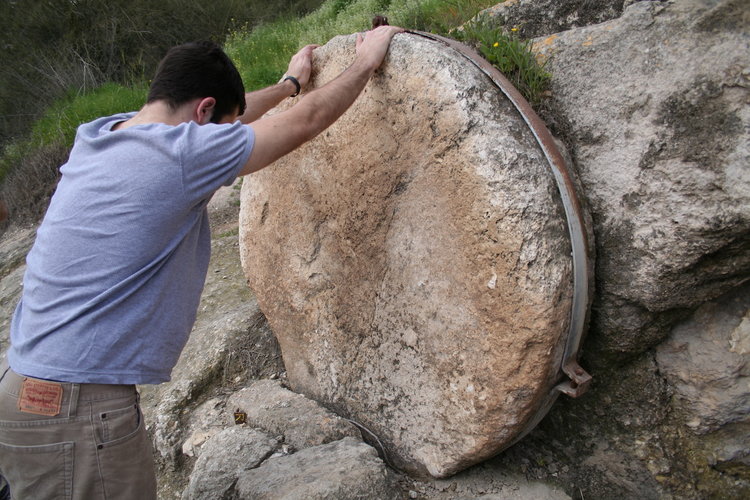The language used by the Gospel writers to describe the action of opening and closing the tomb of Jesus falls in one of two directions.
The rolling stone tomb found in East Jerusalem often mistakenly called "The Tomb of the Kings." It is now believed to be the burial site of Queen Helen of Adiabene (early 1st century AD). I highlighted the rolling stone on the left image to give a clearer sense of scale.
Matthew, Mark, and Luke use variations of the Greek verb kulio, "to roll," to describe what happened. It is a word carrying the idea of circularity. Matthew 27:60 suggests that Joseph of Arimathea took a large stone and "rolled it against" (proskulio) the tomb opening. An angel "rolled it back off" (apokulio) to create separation and sat on it (28:2).
Similarly, in Mark (16:3, 4) the women who travel to the tomb wonder who will "roll the stone off" and are shocked when they discover that it has already happened (again our friend, apokulio). No agency (earthquake or angel) is described by Mark as in the case of Matthew. It is simply a done deal.
Luke follows the synoptic suit. In 24:2 the stone is simply "rolled off" (apokulio).
Odd John uses different language. For the apostle, the stone is "removed," "lifted off" or "flung away." The sense here is now carried by a different Greek verb, hairo, which elsewhere describes the act of pulling up an anchor from the seabed or--think about this--a patch that is ripped off an old garment. Very cool.
There are a number of Second Temple Period tombs in the lower reaches of the Hinnom Valley in Jerusalem. This one is in somebody's backyard.
Archaeologists in Israel/Palestine have found two kinds of cut stone doors used to close tombs. The most common is often described in Hebrew as a golal (again from a verb suggesting circularity). However, they are not always round. They could be plug- or even cube-like in shape. They did not need to be enormous, as the door-opening for the majority of rock-hewn tombs in Jerusalem are smaller than you would expect, not much bigger than two-by-two feet square (climbing in and out of such tombs is more like climbing in and out of a small window--a little wiggling is required!). Nonetheless, even at this size, the plug would still be heavy and difficult to flip, especially if it was wedged in some way into the opening.
Reconstruction of a first century tomb. Note the cuboid plug or stopper (golal) that would be used to close the door. Image from here.
The other sort of stone door is the disk like the one in the image below. These are exceedingly rare and the number of known examples from the Heartland can probably be counted on the fingers of two hands.
Friday I posted an image of this same tomb in our POTD (see here). It is located in a roadcut at the base of Tell Abu Shusha, Israel. This image reveals something more. When the stone disk (left side of the image) is shoved into place in front of the tomb doorway, it drops into a pocket cut in the bedrock. You might even say that by this action, the door is "locked." In order to open this door one must not only have the strength to rotate the stone it on its cut edge, but have enough muscle and leverage to hoist it up and out of the pocket. No easy task!
Note the disk-shaped stone to the left, the "pocket" to receive it just below. Curbing would hold it in place.
Elaborate tombs like this are not the domain of the rich. They are the domain of the uber-rich. It is possible that Joseph of Arimathea's tomb had a door like the one pictured above, but I'm guessing that a plug is more likely.
You might say it was "rolled away" on that epic first day of the week, but I prefer to think that it was ripped out. Like a patch off an old pair of pants.
Then flung like a frisbee.
One of our Bible Land Explorer poses for scale. The steel band on this rolling stone should help prevent looters from taking it.
Join Mark and Vicki on a Mediterranean Cruise October 11-22, 2018. Sites on the program include Rome, Athens, and other Greek islands. Prices begin at $3,898 from New York. Find details by clicking here. It promises to be a getaway of good food, sites, and company!






